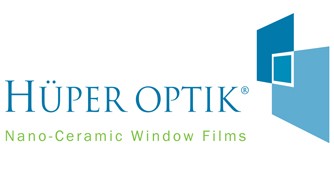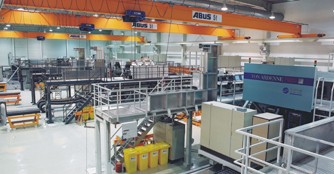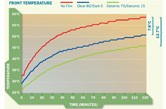Hüper Optik - The Pioneers Of Advanced Nano-Ceramic Car Window Films
15 Feb 2013|16,125 views
Introduction
Unlike modern architecture, glass was not a main material during construction back in the early 20th Century. First few generations of automobiles had less than 20 square feet of glass whilst buildings also featured more bricks.
The application of glass spread over the ages as society evolved and so did the respect for the arts and design. Just compare the difference in architectural design between the Marina Bay financial district and Shenton Way. The trend of using glass has not spared the automobile industry as well - with the current range of cars offering windscreens that are extended all the way to the roof for a 'panoramic experience'.
Functions and History of Window Films
Window films generally consist of a layer of plastic with an adhesive to create a covering for glass. Originally developed as a retrofit upgrade to improve aesthetics or to block an external observer's view of one's interior, window films today are recognised for their ability in rejecting infrared heat on top of offering protection against glare - quite essential for a tropical country like Singapore.
Most window films also have an added safety feature where in time of an impact to the glass, the strong adhesive coating on the film can hold shattered glass together, preventing injury to car occupants or individuals in buildings.
The foundations of window tinting originally started with the application of liquid tint which then developed into polyester-based dye before moving on to metallised films. These 'advanced' technologies of that time dominated the window film market for three decades with limited growth for innovation.
As the application of glass grew however, the limitations of dyed and metallised solar films started to surface - heat rejection was low, and there were numerous complaints of discoloration, fading, oxidisation and interference with radio & wireless signals.
Background of Hüper Optik® International
Back in 1994 Hüper Optik® International embarked on a mission to find a new material that would solve complaints associated with then-existing window films. They had an extremely ambitious aim of producing a window film without dyes or metals, and yet at the same time, offer superb heat rejection and durability.
To do so, they travelled to Germany - the home to a number of prominent researchers in various scientific disciplines and was provided an opportunity to work with Germany's leading organisation of applied research, Fraunhofer-Gesellschaft Institute, through collaboration with Singapore's PSB Corporation.
This intensive process of research and development yielded advanced nano-ceramics as a forefront candidate towards achieving their lofty goals as such materials had been utilised by race cars to reduce under bonnet temperatures and more notably, NASA, on its space shuttles to protect the delicate machine from extremely high temperatures when the shuttles re-enter our atmosphere.
Development of multi-layered Titanium Nitride sputtered window films
Literally leveraging from this space-age technology, numerous research papers were crafted around the advanced nano-ceramic material known as Titanium Nitride (TiN). In 1995, utilising a delicate and complex manufacturing process called sputtering, the world's first prototype of a TiN based window film was deviced.
As a smart coating, TiN possesses multiple functionalities.
Firstly, the heat rejection performance is superior, as it is able to reject up to 96 percent of the infrared energy from the sun. This is far more superior to today's state of technology in dyed or metallised films. In a temperature test study, the Hüper Optik® TiN sputtered films were capable of reducing temperatures by up to 13 degree Celsius after a 120 minute exposure to a halogen light source as compared to a vehicle with no film.
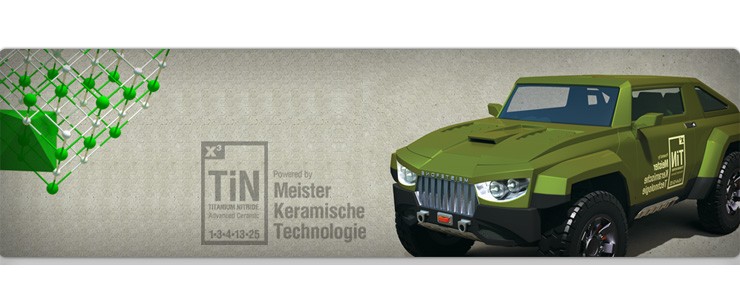 |
Secondly, the ceramic nature of TiN means that the films are highly durable and capable of operating in corrosive environments such as in marine settings. The inter-molecular bonding of the TiN particles are strong enough to withstand deterioration caused by prolonged solar exposure such as fading that is commonly seen in dyed films. In an accelerated weathering test between dyed film and Hüper Optik® TiN film, the advanced nano-ceramic film from Hüper Optik® was shown to offer 25 time more durability than conventional dyed films.
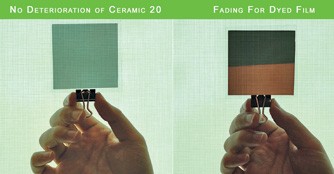
As the world's first and only window film company to obtain a patent for its nano-ceramic offerings, Hüper Optik® is so confident in their products that a 10-year manufacturer backed warranty is given for their advanced nano ceramic films!
And the accolades followed!
Backed by the German heritage and technology, the accolades for Hüper Optik® have been flowing in since official commercialisation in 1999.
In the automotive space, numerous prestigious car brands have chosen Hüper Optik® as the preferred window film choice. These include the well known Big Three continental brands of Mercedes-Benz, BMW, Audi, as well as popular Japanese brands such as Toyota, Lexus and Honda.
Within the architectural domain, Hüper Optik® films have achieved US NFRC certification and also gained recognition as a contributor towards LEEDS accreditation for green building development.
It was also the only product to be featured in Popular Science magazine as a building material in building a 'Dream Green Home'. These developments have led to renowned installations such as Googleplex, Trump Tower, Marriot hotel, Ritz-Carlton and our very own National Museum of Singapore!
Recent developments have seen Hüper Optik® introducing their Ceramic 70 series window film, a new product manufactured using a proprietary deposition technology that blocks up to 91 percent of infrared heat despite allowing maximum visible light into the car cabin. This is complemented with their safety and security films known as Huper SCHILD which has undergone stringent bomb blast and impact tests.
Location and Contact information
Today, Hüper Optik® is represented worldwide with distribution available in 24 countries through 1,200 dealers. For more information on obtaining Hüper Optik® products in Singapore, please call 6643 6730.
Alternatively, you can visit them at www.huperoptik.com/en/company or email them at [email protected] for more enquires.
Hüper Optik® International
9 North Buona Vista Drive #05-01
The Metropolis Tower 1 Singapore 138588
Tel: (65) 6831 3064
Fax: (65) 6734 9231
Email: [email protected]
Authorised Dealers
Astrotech Engineering Pte Ltd (Architecture and Automotive)
71 Toh Guan Road East,
#01-01, TCH Tech Centre, Singapore 608598
Tel: (65) 6899 7950
Fax: (65) 6899 4889
Email: [email protected]
Elittint Pte ltd (Architecture)
7030 Ang Mo Kio Avenuve 5,
#04-53, Northstar, Singapore 569880
Tel: (65) 8418 8922
Fax: (65) 6570 8276
Email: [email protected]
Introduction
Unlike modern architecture, glass was not a main material during construction back in the early 20th Century. First few generations of automobiles had less than 20 square feet of glass whilst buildings also featured more bricks.
The application of glass spread over the ages as society evolved and so did the respect for the arts and design. Just compare the difference in architectural design between the Marina Bay financial district and Shenton Way. The trend of using glass has not spared the automobile industry as well - with the current range of cars offering windscreens that are extended all the way to the roof for a 'panoramic experience'.
Functions and History of Window Films
Window films generally consist of a layer of plastic with an adhesive to create a covering for glass. Originally developed as a retrofit upgrade to improve aesthetics or to block an external observer's view of one's interior, window films today are recognised for their ability in rejecting infrared heat on top of offering protection against glare - quite essential for a tropical country like Singapore.
Most window films also have an added safety feature where in time of an impact to the glass, the strong adhesive coating on the film can hold shattered glass together, preventing injury to car occupants or individuals in buildings.
The foundations of window tinting originally started with the application of liquid tint which then developed into polyester-based dye before moving on to metallised films. These 'advanced' technologies of that time dominated the window film market for three decades with limited growth for innovation.
As the application of glass grew however, the limitations of dyed and metallised solar films started to surface - heat rejection was low, and there were numerous complaints of discoloration, fading, oxidisation and interference with radio & wireless signals.
Background of Hüper Optik® International
Back in 1994 Hüper Optik® International embarked on a mission to find a new material that would solve complaints associated with then-existing window films. They had an extremely ambitious aim of producing a window film without dyes or metals, and yet at the same time, offer superb heat rejection and durability.
To do so, they travelled to Germany - the home to a number of prominent researchers in various scientific disciplines and was provided an opportunity to work with Germany's leading organisation of applied research, Fraunhofer-Gesellschaft Institute, through collaboration with Singapore's PSB Corporation.
This intensive process of research and development yielded advanced nano-ceramics as a forefront candidate towards achieving their lofty goals as such materials had been utilised by race cars to reduce under bonnet temperatures and more notably, NASA, on its space shuttles to protect the delicate machine from extremely high temperatures when the shuttles re-enter our atmosphere.
Development of multi-layered Titanium Nitride sputtered window films
Literally leveraging from this space-age technology, numerous research papers were crafted around the advanced nano-ceramic material known as Titanium Nitride (TiN). In 1995, utilising a delicate and complex manufacturing process called sputtering, the world's first prototype of a TiN based window film was deviced.
As a smart coating, TiN possesses multiple functionalities.
Firstly, the heat rejection performance is superior, as it is able to reject up to 96 percent of the infrared energy from the sun. This is far more superior to today's state of technology in dyed or metallised films. In a temperature test study, the Hüper Optik® TiN sputtered films were capable of reducing temperatures by up to 13 degree Celsius after a 120 minute exposure to a halogen light source as compared to a vehicle with no film.Secondly, the ceramic nature of TiN means that the films are highly durable and capable of operating in corrosive environments such as in marine settings. The inter-molecular bonding of the TiN particles are strong enough to withstand deterioration caused by prolonged solar exposure such as fading that is commonly seen in dyed films. In an accelerated weathering test between dyed film and Hüper Optik® TiN film, the advanced nano-ceramic film from Hüper Optik® was shown to offer 25 time more durability than conventional dyed films.

As the world's first and only window film company to obtain a patent for its nano-ceramic offerings, Hüper Optik® is so confident in their products that a 10-year manufacturer backed warranty is given for their advanced nano ceramic films!
And the accolades followed!
Backed by the German heritage and technology, the accolades for Hüper Optik® have been flowing in since official commercialisation in 1999.
In the automotive space, numerous prestigious car brands have chosen Hüper Optik® as the preferred window film choice. These include the well known Big Three continental brands of Mercedes-Benz, BMW, Audi, as well as popular Japanese brands such as Toyota, Lexus and Honda.
Within the architectural domain, Hüper Optik® films have achieved US NFRC certification and also gained recognition as a contributor towards LEEDS accreditation for green building development.
It was also the only product to be featured in Popular Science magazine as a building material in building a 'Dream Green Home'. These developments have led to renowned installations such as Googleplex, Trump Tower, Marriot hotel, Ritz-Carlton and our very own National Museum of Singapore!
Recent developments have seen Hüper Optik® introducing their Ceramic 70 series window film, a new product manufactured using a proprietary deposition technology that blocks up to 91 percent of infrared heat despite allowing maximum visible light into the car cabin. This is complemented with their safety and security films known as Huper SCHILD which has undergone stringent bomb blast and impact tests.
Location and Contact information
Today, Hüper Optik® is represented worldwide with distribution available in 24 countries through 1,200 dealers. For more information on obtaining Hüper Optik® products in Singapore, please call 6643 6730.
Alternatively, you can visit them at www.huperoptik.com/en/company or email them at [email protected] for more enquires.
Hüper Optik® International
9 North Buona Vista Drive #05-01
The Metropolis Tower 1 Singapore 138588
Tel: (65) 6831 3064
Fax: (65) 6734 9231
Email: [email protected]
Authorised Dealers
Astrotech Engineering Pte Ltd (Architecture and Automotive)
71 Toh Guan Road East,
#01-01, TCH Tech Centre, Singapore 608598
Tel: (65) 6899 7950
Fax: (65) 6899 4889
Email: [email protected]
Elittint Pte ltd (Architecture)
7030 Ang Mo Kio Avenuve 5,
#04-53, Northstar, Singapore 569880
Tel: (65) 8418 8922
Fax: (65) 6570 8276
Email: [email protected]
Merchant Information
Huper Optik International Pte Ltd
Address9 North Buona Vista Drive #05-01 The Metropolis Tower 1 S(138588)
(map)
Phone68313064
Thank You For Your Subscription.

















